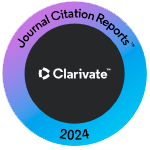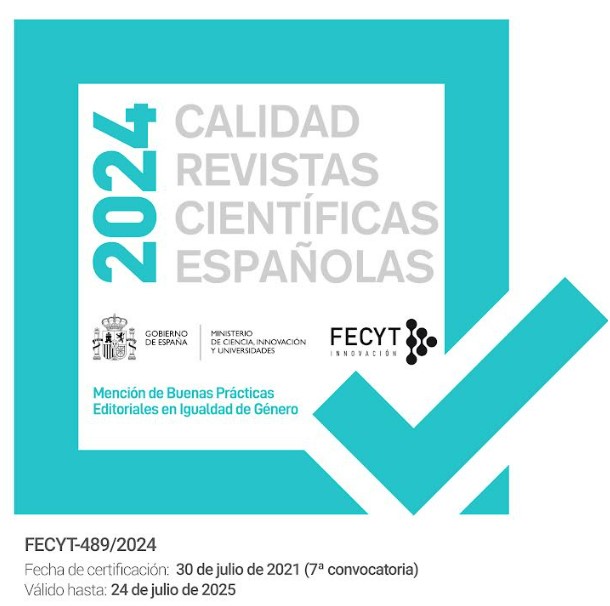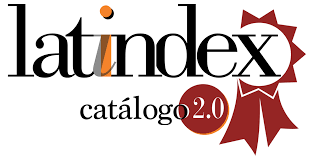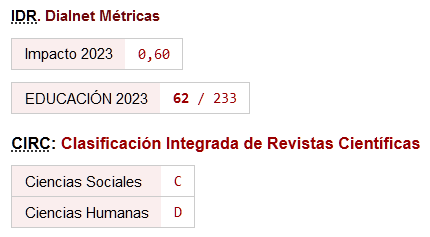La interacción de la instrucción explícita del pensamiento crítico, el rendimiento de la escritura académica, la capacidad de pensamiento crítico y las disposiciones de pensamiento crítico: un estudio experimental
DOI:
https://doi.org/10.46661/ijeri.4594Palabras clave:
Rendimiento académico de escritura, inventario de disposiciones de pensamiento crítico, instrucción explícita de pensamiento crítico, prueba de ensayo de pensamiento crítico de Ennis-WeirResumen
El presente estudio tuvo la intención de investigar la interacción de la enseñanza explícita del pensamiento crítico, el rendimiento de la escritura académica, la capacidad de pensamiento crítico y las disposiciones de pensamiento crítico de los estudiantes iraníes. Con este fin, se seleccionaron 140 estudiantes de la Universidad de Ciencias Médicas de Jahrom (73 hombres y 67 mujeres). Se dividieron en los grupos experimentales y de control. Ambos grupos recibieron instrucción en cursos de escritura académica durante 15 semanas 3 horas por semana. A los estudiantes de ambos grupos se les administraron pruebas previas y posteriores a la instrucción para examinar la efectividad de la instrucción. Se utilizaron tres instrumentos en este estudio, incluyendo la prueba de ensayo desarrollada por el investigador, la Prueba de ensayo de pensamiento crítico Ennis-Weir y el Inventario de disposiciones de pensamiento crítico de California (CCTDI). La estadística descriptiva y la prueba t de muestras independientes se utilizaron para analizar los datos. Los resultados indicaron que hubo diferencias estadísticamente significativas entre las puntuaciones medias de los grupos experimental y control. Los resultados también mostraron que algunas subescalas de CCTDI no fueron significativamente diferentes en la prueba posterior, como la búsqueda de la verdad, la madurez cognitiva y la mentalidad abierta, mientras que las puntuaciones medias posteriores a la prueba de otras subescalas de CCTDI fueron significativamente diferentes, como analiticidad, curiosidad por TC, CT confianza en sí mismo y sistemática. El grupo experimental tuvo una puntuación más alta en la prueba de escritura académica en comparación con el grupo de control. Los cambios en la capacidad de pensamiento crítico de los estudiantes, el rendimiento de la escritura académica y sus disposiciones de pensamiento crítico sugieren que las técnicas de CT han sido fructíferas, y se deben hacer más esfuerzos para integrar la instrucción explícita en pensamiento crítico en los cursos académicos.
Descargas
Citas
Abrami, P. C., Bernard, R. M., Borokhovski, E., Wade, A., Surkes, M. A., Tamim, R., & Zhang, D. (2008). Instructional interventions affecting critical thinking skills and dispositions: A stage 1 meta-analysis. Review of Educational Research, 78(4), 1102-1134.
American Philosophical Association [APA] (1990). Critical Thinking: A Statement of Expert Consensus for Purposes of Educational Assessment and Instruction, The Delphi Report: Research Findings and Recommendations Prepared for the Committee on Pre-College Philosophy. P. Facione, (Project Director). ERIC Doc. No. ED 315-423.
Bartlett, F.C. (1958). Thinking: An experimental and social study. London: Unwin University Books.
Beyer, B. K. (1985). Teaching critical thinking: A direct approach. Social Education, 49(4), 297-303.
Bloom, B.S. (1956). Taxonomy of educational objectives: Classification of educational goals. New York: Longmans, Green.
Case, R. (2005). Moving critical thinking to the main stage. Education Canada, 45(2), 45-49.
Chaffee, J., McMahon, C. & Stout, B. (2002). Critical thinking thoughtful writing. New York: Houghton Mifflin.
Clark, D. (2004). Is professional writing relevant? A model for action research. Technical Communication Quarterly, 13(3), 307-323.
Condon, W., & Kelly-Riley, D. (2004). Assessing and teaching what we value: The relationship between college-level writing and critical thinking abilities. Assessing Writing, 9(1), 56-75.
Coughlin, E. (2010). High schools at a crossroads. Educational Leadership, 67(7), 48-60.
Dewey, J. (1933a). How we think: A restatement of the relation of reflective thinking to the educative process. Chicago: Henry Regnery.
Ennis, R. H. (1985). Critical thinking and the curriculum. National Forum, 65(1), 28-31.
Ennis, R. H. (1987). A taxonomy of critical thinking dispositions and abilities. In J. B. Baron & R. J. Sternberg (Eds.), Teaching Thinking Skills. Theory and Practice (pp. 9-26). N. York: W. H. Freeman and Company.
Ennis, R. H. (2005). Supplement to the test/manual entitled he Ennis-Weir critical thinking essay test. Urbana, IL: The Illinois Critical Thinking Project.
Ennis, R. H., & Weir, E. E. (1985). The Ennis-Weir critical thinking essay test: An instrument for teaching and testing. Midwest Publications.
Facione, N. C., & Facione, P. A. (1997). Critical thinking assessment in nursing education programs: An aggregate data analysis. Millbrae: California Academic Press.
Facione, P. A. (1990). Critical thinking: A statement of expert consensus for purposes of educational assessment and instruction. Millbrae, CA: The California Academic Press.
Facione, P. A. (2000). The disposition toward critical thinking: Its character, measurement, and relationship to critical thinking skill. Informal logic, 20(1), 61-84.
Facione, P. A., Sanchez, C. A., Facione, N. C., & Gainen, J. (1995). The disposition toward critical thinking. The Journal of General Education, 44(1), 1-25.
Fasko, D. (2003). Critical thinking: origins, historical development, future direction. In D. Fasko (Ed.), Critical thinking and reasoning: Current research, theory and practice (pp.3-20). Cresskill, NJ: Hampton Press.
Gilhooly, K. (1996). Thinking: Directive, undirected, and creative. Amsterdam: Academic Press.
Halonen, J. S. (1995). Demystifying critical thinking. Teaching of psychology, 22(1), 75-81.
Halpern, D. F. (1998). Teaching critical thinking for transfer across domains. American Psychologist, 53(4), 449-455.
Halpern, D. F. (2007). The nature and nurture of critical thinking. In R. J. Sternberg, H. L. Roediger III, & D. F. Halpern (Eds.), Critical thinking in psychology (pp. 1-14). New York, NY, US: Cambridge University Press.
Hinkel, E. (2003). Teaching academic ESL writing: Practical techniques in vocabulary and grammar. New York: Routledge.
Jones, P. J., & Haydon, D. (Eds.). (2012). Putting it into practice: Developing student critical thinking skills in teacher education. Charlotte, NC: Information Age.
Kennedy, M., Fisher, M. B., & Ennis, R. H. (1991). Critical thinking: Literature review and needed research. Educational Values and Cognitive Instruction, 15 (3). 111-126.
King, A. (1994). Inquiry as a tool in critical thinking. In D. F. Halpern (Ed.), Changing college classrooms: New teaching and learning strategies for an increasingly complex world (pp. 13-38). San Francisco: Jossey-Bass.
Kurfiss, J. (1988). Critical thinking: Theory, research, practice and possibilities. Washington: Higher Education.
Lewis, A., & Smith, D. (1993). Defining higher order thinking. Theory into Practice, 32(3), 131-137.
Lipman, M. (1988). Critical thinking: What can it be? Educational Leadership, 46(1), 38-43.
Lipman, M. (2003). Thinking in education. Cambridge: Cambridge University Press.
McPeck, J. (1981). Critical thinking and education. New York: St. Martin's.
Mirman, J., & Tishman, S. (1988). Infusing thinking through connections. Educational Leadership, 45(7), 64-65.
Paul, R. & Elder, L. (2007). Critical thinking: The art of Socratic questioning. Journal of Developmental Education, 31(1), 36-37.
Paul, R. (1985). The critical thinking movement. National Forum, 65(1), 23-32.
Paul, R. (1992). Critical thinking: What, why, and how. New directions for community colleges, 92(77), 3-24.
Paul, R. and Elder, L. (2008). The miniature guide to critical thinking concepts and tools. Dillon Beach: Foundation for Critical Thinking Press.
Paul, R., & Elder, L. (2001). Critical thinking: Tools for taking charge of your learning and your life. Upper Saddle River, NJ: Prentice Hall.
Pescatore, C. (2007). Current events as empowering literacy: For English and social studies teachers. Journal of Adolescent & Adult Literacy, 51(4), 326-339.
Quitadamo, I. J., & Kurtz, M. J. (2007). Learning to improve: using writing to increase critical thinking performance in general education biology. CBE-Life Sciences Education, 6(2), 140-154.
Ramsden, P., & Moses, I. (1992). Associations between research and teaching in Australian higher education. Higher Education, 23(3), 273-295.
Reed, J. H. (1998). Effect of a model for critical thinking on students' achievement in primary source document analysis (PhD dissertation). University of south Florida, The United States.
Reed, J. H. (1998). Effect of a model for critical thinking on students' achievement in primary source document analysis (PhD dissertation). University of south Florida, The United States.
Scanlan, J.S. (2006). The effects of Richard Paul’s universal elements and standards of reasoning on twelfth grade composition (Master’s thesis). Alliant International University, USA.
Sims, M. (2014). The write stuff: Thinking through essays. USA: Pearson Prentice Hall.
Steele, C. M. (1997). A threat in the air: How stereotypes shape intellectual identity and performance. American Psychologist, 52(6),613-629.
Sternberg, R. J. (1986). Critical thinking: Its nature, measurement, and improvement. Washington, D. C.: National Institute of Education.
Tsui, L. (2002). Fostering critical thinking through effective pedagogy: Evidence from four institutional case studies. The Journal of Higher Education, 73(6), 740-763.
Willingham, D. T. (2008). Critical thinking: Why is it so hard to teach? Arts Education Policy Review, 109(4), 21-32.
Worrell, J. A., & Profetto-McGrath, J. (2007). Critical thinking as an outcome of context-based learning among post RN students: A literature review. Nurse Education Today, 27(5), 420-426.
Descargas
Publicado
Cómo citar
Número
Sección
Licencia
Derechos de autor 2020 Creative Commons 4.0

Esta obra está bajo una licencia internacional Creative Commons Atribución-NoComercial-SinDerivadas 4.0.
















